Cycling Health and Safety
Benefits
outweigh manageable risks
Bicycle technology is, in many areas of the world, an essential part of the rural and urban mobility mix. Among the benefits of cycling: heath benefits (significant reduction in cardiovascular disease, stroke, obesity, Type-2 diabetes, colon/breast cancers, osteoporosis, depression, dementia), no direct fossil fuel use, reduces air pollution, lower cost, improves livability of cities, reduces noise, greater door-to-door mobility in speed and distance (by up to 4x) than walking, greater freedom of movement than scheduled public transport, load carrying/pulling ability, recreation/touring activity, and well suited to meeting the bulk of local transportation needs. For the less affluent, cycling may be the only affordable way to get to work and access basic needs.
The amount of time a person sits during the day is
associated with a higher
risk of disease and death, regardless of regular
exercise. Prolonged sedentary behavior is associated with a
15 to 20 per cent higher risk of death from any cause, and
as much as a 90% increased risk of developing diabetes. Even
engaging in 30 to 60 minutes of moderate to vigorous
exercise daily does not mean it's OK to be inactive for the
rest of the day. Consider two hours of moderate walking
level of activity to be minimal, and the average America
manages just over one hour, meaning half manage even less.
The average Amish adult (who can still ride in a buggy
unlike our pre-18th century ancestors and most of our 19th
century ones) walks only 8 miles a day, while the average
American manages 2.5 miles/day (walking from bed to
bathroom, to car.....). Activity intolerance, as induced by
cars and a host of "labor" saving (read "movement" saving)
devices, as relentlessly promoted by writers of ad copy, is
a form of slow suicide by often slow death. Selling slow
suicide is, for some reason, still legal, while refusing to
buy movement saving stuff (credit allowing) is still not yet
illegal, perhaps because what is unthinkable doesn't need to
be criminalized.
While cycling is becoming more popular among those who could drive cars instead, all benefits considered, riding cycles in traffic is inherently unsafe. Bicycle lanes are good (sometimes essential), while bicycle paths separated from high-power traffic are better. Pedestrians and cyclists among cars and trucks are less safe and a cyclist among pedestrians or other cyclists is more safe than a car driver or their passengers among cars.
Although not taking to a sidewalk on rare occasions, such
as crossing a narrow busy overpass with no bike lane, can be
hazardous, those who habitually ride on sidewalks, which in
most places is illegal apart from posing a hazard to
pedestrians, are about seven times more likely to be hit at
intersections or where vehicles turn into or out of
driveways than those who ride in traffic, whether there is a
bike lane or not.
If personal safety is the only consideration, get a Humvee, preferably with a machine gun turret, and add extra body armor. Otherwise, consider the risks of various transportation choices and moderate them. Death and injury are negative health impacts, but on balance the positive health impacts of cycling far outweigh the negative. Cycling risks involve where you live, so consider:
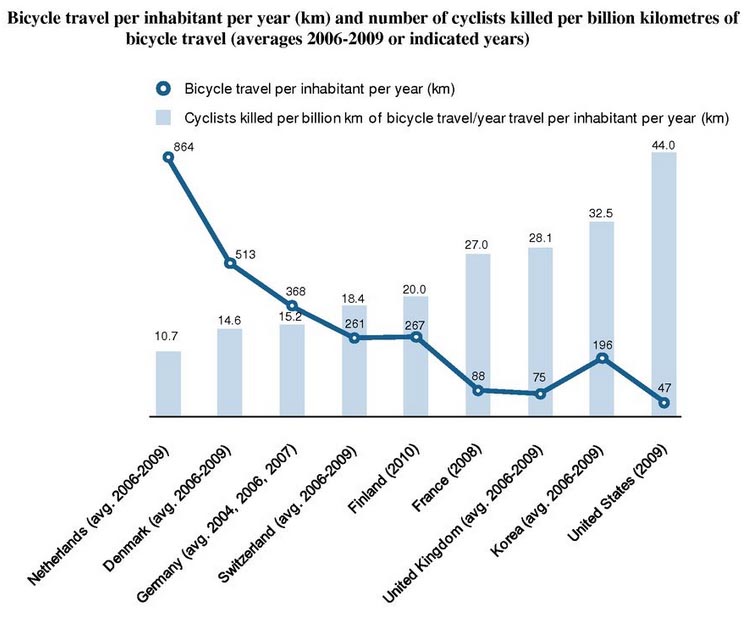
Netherlanders are 18 times more inclined to ride bikes than
Americans (average American rides a bike 29 miles a year vs.
the Netherlander who rides 537 miles), yet American cyclists
are 4 times more likely to be killed per mile of travel. The
Netherlands has a well developed bicycle transportation
infrastructure. Motorists are more aware of bicycles, more
willing to share the (as distinct from 'their') road with
cyclists, and so kill far fewer of them than Americans. The
American high-speed, high-power Car Culture transportation
infrastructure is for cars and trucks, with bicycles often a
distant afterthought. Americans typically view cyclists as
intruders on their roadway. US motorists who hit cyclists
are over four times more likely to run than if they hit a
different vehicle. About half the time, police blame fatal
bicycle crashes (where the cyclist, who could tell no tale,
died) on the cyclist, not the driver.
US cyclists do contribute to their own demise. About a quarter of fatalities involve drunk cyclists (and 16% involve drunk motorists + an unknown percentage of the hit-and-run drivers who were driving under the influence).
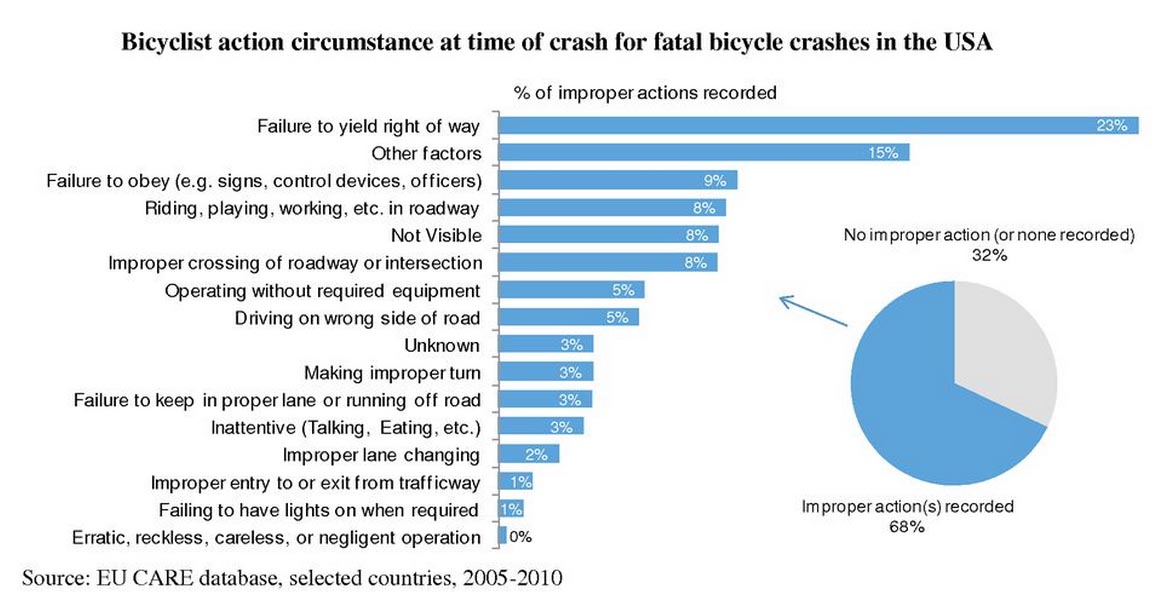
Cars and trucks are bigger than bikes, so cyclists should yield (legal) right of way, and should considering yielding even when they have the (legal) right of way. Intersections pose a special hazard (it's where 36% of fatalities occur). While protected bicycle lanes are appearing in some cities, the next step will have to be protected intersections. Cyclists can pro-actively avoid suicide-by-car by staying out of and away from traffic whenever possible, and by taking the road less traveled by. Motorists often don't see what they are not looking for. Cyclist's friends: lights, flashers, flags, reflectors, slow-moving vehicle reflective sign, bright clothing, hand signals, and a habit of looking ten ways before crossing. Also wear a helmet. Those who don't are called 'organ donors' by emergency medical types, and 73% of cyclists who end up dead neglected to wear one.
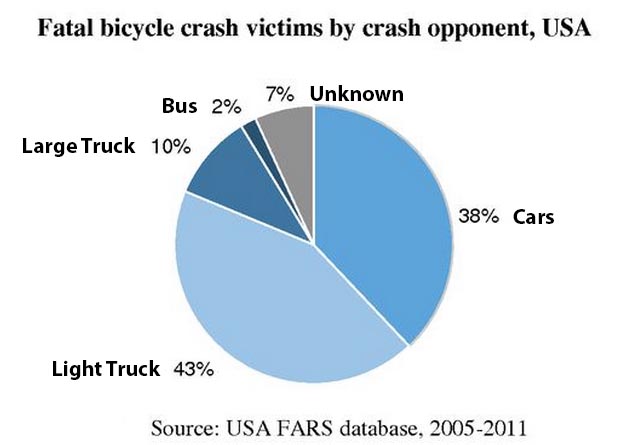
Trucks (light trucks include SUVs) are not a cyclist's friend. Truck drivers look for cars (who could cause minor damage) and not for cyclists. Cars are lower in the high-power hierarchy and are somewhat more wary, more likely to see a cyclist. Cyclists need to be wary—period. Cars kill twice as many Americans as all forms of violence put together. Cyclists who stay away from them live longer and prosper.
Although rear end collisions are not common, they are commonly fatal. Good mirrors are your friend. Running off the road is better than being run over. Under development is an affordable product (Backtracker) that adds rear looking low-power radar to a bicycle. It alerts the cyclist of an over taking car, its speed and distance, but also flashes lights at it to make the cyclist more visible.
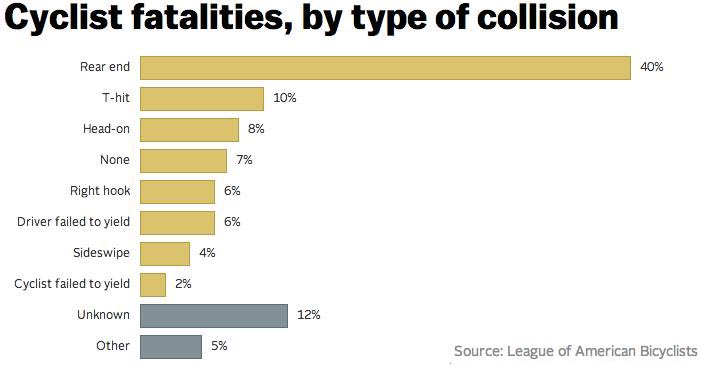
While bicycle paths separated from traffic seem safer,
beware of other cyclists to avoid a bike-on-bike collision,
and if joggers/pedestrians are present, take care to avoid
them. It is possible for cyclists to kill or injure
pedestrians, but best not to. Bicycle paths are typically
two-way, and some cyclists will go too fast, especially
downhill, and reckless riding happens. E-bikes can allow the
weak/inexperienced to speed and thereby become hazards. It
is not enough to not ride recklessly, as the most careful
may become a victim of the careless on bicycle paths. Cars
typically do not habitually travel in marked bicycle lanes,
so any inattention tends not to kill cyclists, and there is
no oncoming bicycle traffic. So bicycle lanes are about as
safe as bicycle paths. Both paths and lanes, however, are
unsafe at intersections, so make special effort to survive intersections.
To repeat: Although cyclists are about 2-3 times more likely to be killed or injured by a car or truck while in traffic than if they were in a car or truck, the health benefits outweigh the risks. You can die suddenly or (more likely) live a longer, healthier, and more productive life. Or you can die a slow miserable death form poor health secondary to low activity level. If your health and longevity are all that matters, then drive a Humvee and get plenty of exercise inside your survival retreat. Otherwise, live the life worth living, consider the risks, and be aware of your surroundings (i.e. don't drink, goof off....). Be both active and pro-active.
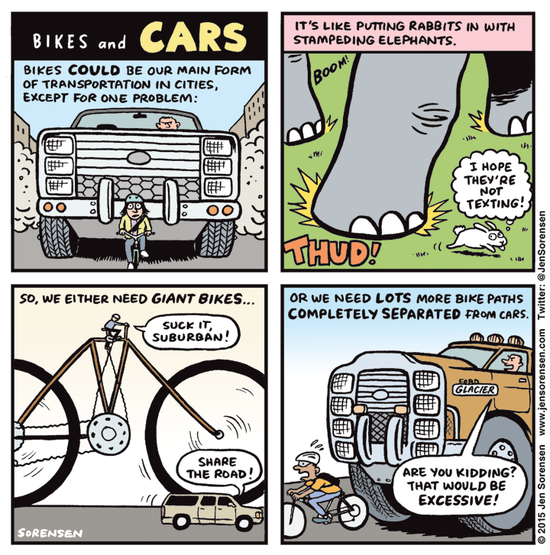
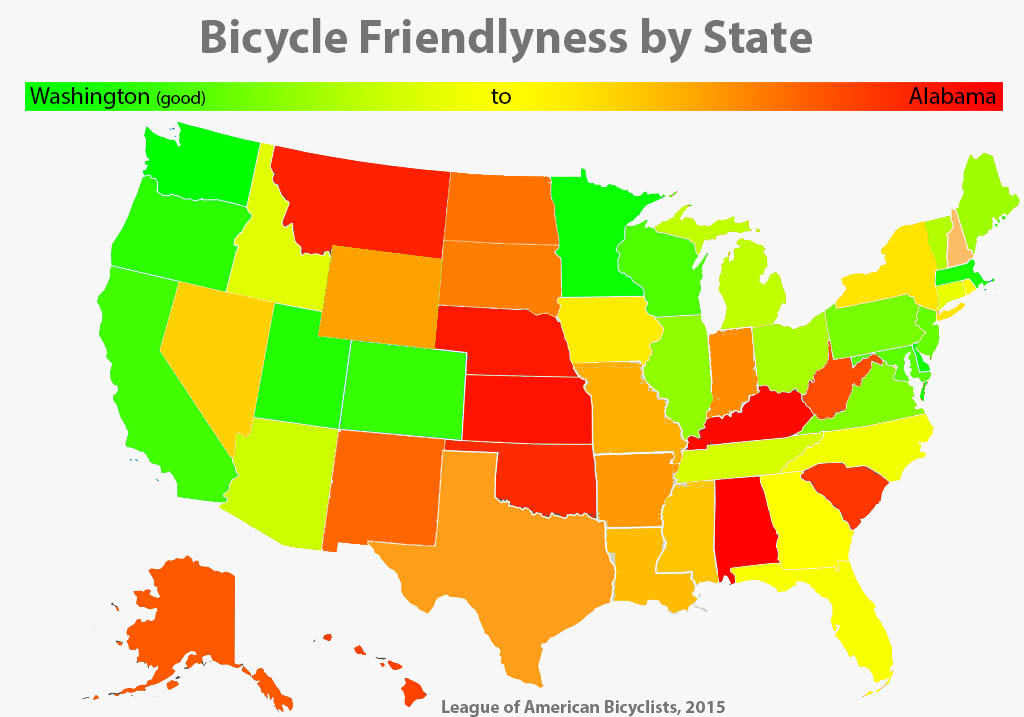
Reference:
http://www.oecd-ilibrary.org/transport/cycling-health-and-safety_9789282105955-en